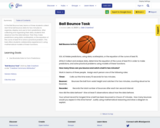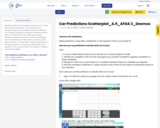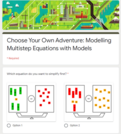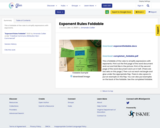
We're Playing Basketball Task Template and Student Version of Task
- Subject:
- Algebra I & II
- Mathematics
- Material Type:
- Lesson Plan
- Provider:
- VDOE
- Author:
- VDOE
- Date Added:
- 10/07/2024

Resources to support Mathematics Standards of Learning for Algebra 1

We're Playing Basketball Task Template and Student Version of Task

Adding and subtracting polynomialsMathematics Instructional Plans (MIPs) help teachers align instruction with the 2016 Mathematics Standards of Learning (SOL) by providing examples of how the knowledge, skills and processes found in the SOL and curriculum framework can be presented to students in the classroom.

From Khan Academy- This site teaches High Schoolers how to create equations through a series of 298 questions and interactive activities aligned to 5 Common Core mathematics skills.

In the Ball Bounce task, teams of three students collect real-time ball bounce data for two minutes to organize, display and use to form predictions. After collecting and organizing their data, students first observe how the data behave. Then they make predictions using data, scatterplots, or the equation of the curve of best fit to solve a
practical problem. This task offers students collaborative experience in using mathematical models of linear functions.

Students research two variables about the car model they intend to purchase. They use Desmos to compare these same variables across five different car models. Students use analysis of bivariate data in order to decide which car makes sense to buy. Students prepare and share a summary statement and include desmos screen shots in order to justify their purchase. This task offers students experiences in making predictions, using data, scatterplots, or the equation of the curve of best fit for decision-making in a practical problem.

Students solve multistep equations (with variables on only one side). Students choose between two models/equations at each of six points in this Google Form activity.

This resource from the Mathematics Assessment Project was found at OER Commons. https://www.oercommons.org/courses/finding-equations-of-parallel-and-perpendicular-lines/view. This lesson unit is intended to help teachers assess how well students are able to understand the relationship between the slopes of parallel and perpendicular lines and, in particular, to help identify students who find it difficult to: find, from their equations, lines that are parallel and perpendicular; and identify and use intercepts.

This is a remix of "Comparing Speeds in Graphs and Equations" by Illustrative Mathematics. The activity can be used to introduce the characteristics of direct variations. There is also a link to a direct and inverse variation foldable.

With your mouse, drag data points and their error bars, and watch the best-fit polynomial curve update instantly. You choose the type of fit: linear, quadratic, cubic, or quartic. The reduced chi-square statistic shows you when the fit is good. Or you can try to find the best fit by manually adjusting fit parameters.

Developing a curve of best fit for dataMathematics Instructional Plans (MIPs) help teachers align instruction with the 2016 Mathematics Standards of Learning (SOL) by providing examples of how the knowledge, skills and processes found in the SOL and curriculum framework can be presented to students in the classroom.

Determining a curve of best fit Mathematics Instructional Plans (MIPs) help teachers align instruction with the 2016 Mathematics Standards of Learning (SOL) by providing examples of how the knowledge, skills and processes found in the SOL and curriculum framework can be presented to students in the classroom.

Determining direct variationMathematics Instructional Plans (MIPs) help teachers align instruction with the 2016 Mathematics Standards of Learning (SOL) by providing examples of how the knowledge, skills and processes found in the SOL and curriculum framework can be presented to students in the classroom.

This a foldable that can be used for teaching the characteristics of direct and inverse variation.

Dividing Polynomials Mathematics Instructional Plans (MIPs) help teachers align instruction with the 2016 Mathematics Standards of Learning (SOL) by providing examples of how the knowledge, skills and processes found in the SOL and curriculum framework can be presented to students in the classroom.

This is a Desmos activity to explore domain and range of continuous functions. Students do not need prior knowledge of domain and range; this is an exploratory instructional activity.

This task asks students to use inverse operations to solve the equations for the unknown variable, or for the designated variable if there is more than one. Two of the equations are of physical significance and are examples of Ohm's Law and Newton's Law of Universal Gravitation.

Students will explore literal equations using pictures/images to represent variables. Students use inverse operations and properties of equality to solve for the specified image.

This a foldable of the rules to simplify expressions with exponents.

Factoring polynomialsMathematics Instructional Plans (MIPs) help teachers align instruction with the 2016 Mathematics Standards of Learning (SOL) by providing examples of how the knowledge, skills and processes found in the SOL and curriculum framework can be presented to students in the classroom.

In this activity, students must find solutions to quadratic equations in order to create a monster with specific characteristics.